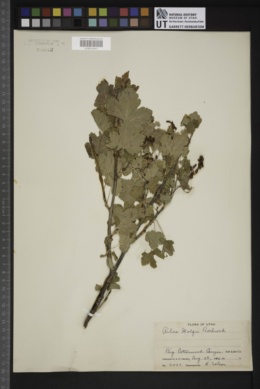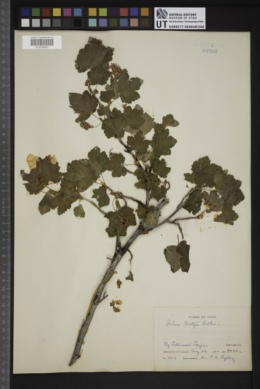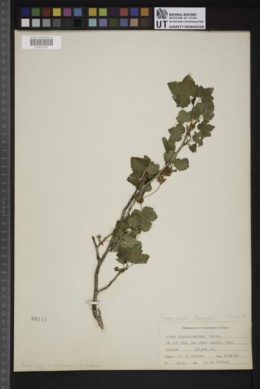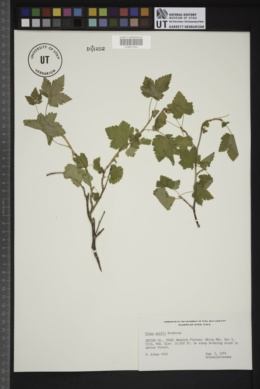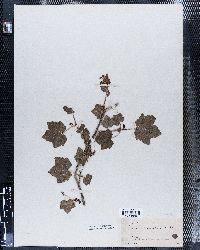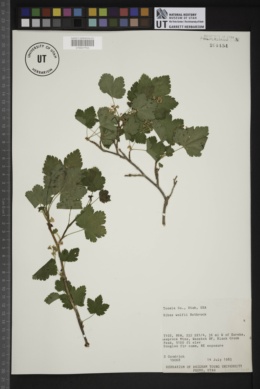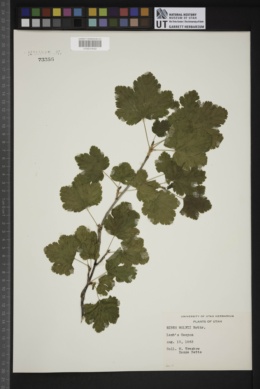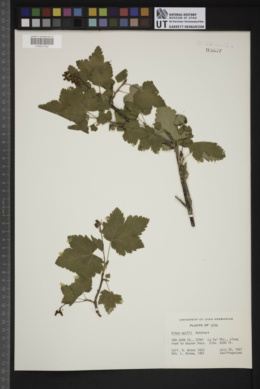Ribes wolfii
|
|
|
|
Family: Grossulariaceae
Winaha Currant, more...Wolf's currant, wolf currant
[Ribes mogollonicum Greene, moreRibes sanguineum var. variegatum S.Watson] |
Plants 1-5 m. Stems spreading to erect, finely crisped-puberulent, stipitate-glandular and with black, sessile glands; spines at nodes absent; prickles on internodes absent. Leaves: petiole (1-)1.7-4.5(-6) cm, finely crisped-puberulent, with colorless, stipitate and sessile glands, stipitate glands on margins of stipular expansion; blade rectangular, 3-5-lobed, shallowly to deeply cleft, 2-6(-7.5) cm, base cordate, surfaces glabrous or sparsely pubescent, ciliate, sometimes with dark, stipitate or sessile, minute glands, especially abaxially, lobes nearly triangular, margins dentate, apex acute to broadly obtuse. Inflorescences erect to spreading, (5-)7-25-flowered racemes, (3.5-)4.5-9.5(-12) cm, axis finely crisped-puberulent and stipitate-glandular, flowers evenly spaced. Pedicels jointed, (0.5-)1.5-6(-8.3) mm, finely crisped-puberulent and stipitate-glandular; bracts elliptic-lanceolate, (2.8-)3-5.2(-7) mm, puberulent-glandular. Flowers: hypanthium greenish or pinkish, cup-shaped to turbinate, (0.8-)1.2-1.5(-2.1) mm, surfaces with scattered or dense, yellow or green, stipitate glands abaxially, glabrous adaxially; sepals not overlapping, spreading, greenish or pinkish, lanceolate to elliptic-lanceolate, (2-)3.3-4.1 mm; petals widely separated, erect, cream, yellowish green, or pinkish, obovate or flabellate-cuneate, not conspicuously revolute or inrolled, 0.9-1.5 mm; nectary disc not seen; stamens slightly longer than petals; filaments linear to slightly broader at base, 0.8-1.2 mm, glabrous; anthers cream, oval, 0.5-0.6 mm, apex with dark, small depression; ovary glandular-pubescent with green, yellow, or colorless, short-stipitate glands; styles nearly distinct or connate to 1/2 their lengths, 1-2 mm, glabrous. Berries palatable, black, ovoid, 3-12 mm, glandular-pubescent. Flowering May-Aug. Moist woods and meadows; 1600-3800 m; Ariz., Colo., Idaho, N.Mex., Oreg., Utah, Wash. Ribes mogollonicum is included here in R. wolfii because the two taxa, morphologically, seem to overlap completely. A. E. Senters and D. E. Soltis (2003) placed R. mogollonicum near R. viscosissimum and R. erythrocarpum.
Common Name: Wolf's currant Duration: Perennial Nativity: Native Lifeform: Shrub General: Deciduous shrub, 0.5-3 m (1.6-10 ft) tall; unarmed; stems spreading to erect; branches gray with or without a white bloom, becoming reddish to dark brown with age; twigs orangish tan, slightly pubescent with curved hairs and stalked glands. Leaves: Alternate, simple, nearly orbicular in outline, 1.2-6 cm long, 1.2-9 cm wide, with 3-5 broadly triangular lobes, green and glabrous or slightly pubescent above, pale green with prominent net-like veins and stalked or sessile glands below, margins irregularly toothed; petioles 0.7-4.5 cm long. Flowers: Dense racemes 7-25 flowered; subtending bracts elliptic- lanceolate, 3-5 mm long; pedicels 1.5-6 mm long, finely pubescent with curved hairs and stalked glands, not jointed below the ovary; ovary densely stalked-glandular; hypanthium cup-shaped, 1.2-1.5 mm long, greenish yellow to white or off-white; calyx lobes 3-4 mm long, white, spreading but becoming erect after flowering; petals 1- 1.5 mm long, off-white, yellowish green, or pinkish; stamens equaling the petals; styles glabrous. Fruits: Berry, ovoid, 3-6 (10) mm in diameter, black, with stalked glands; seeds 1.8-2.7 mm long. Ecology: Found in moist coniferous forests and meadows from 8,500- 11,500 ft (2591-3505 m), flowers May-August. Distribution: Apache, Coconino, and Graham counties; northwestern and southwestern U.S. Ethnobotany: Fruit is eaten raw, dried, ground, or as an ingredient in jelly. Editor: Springer et al. 2011 |







